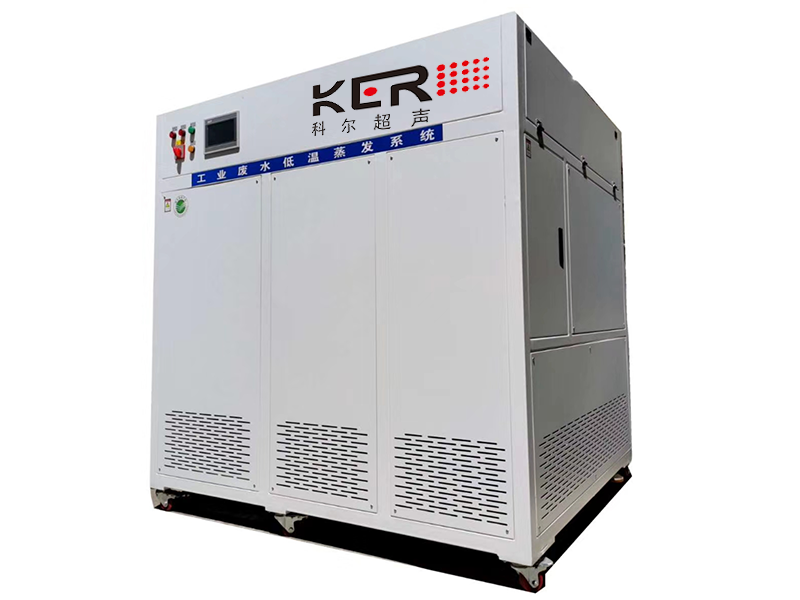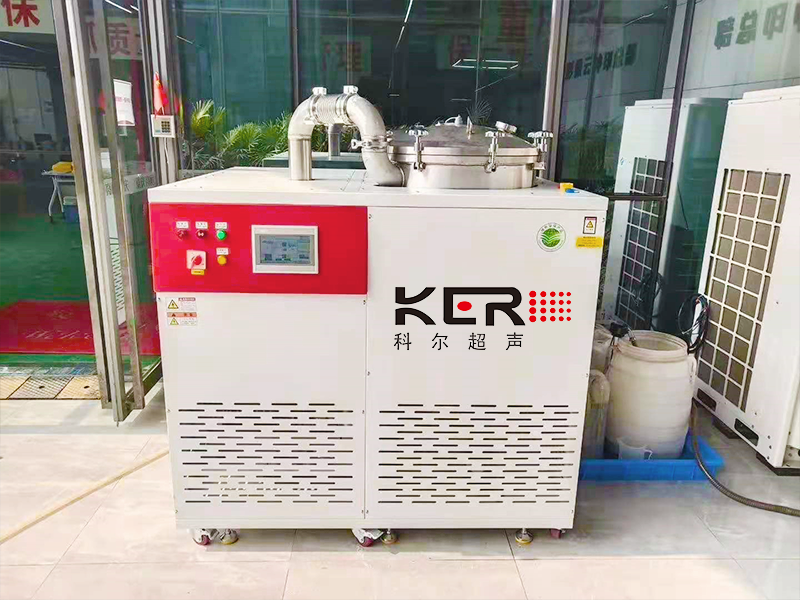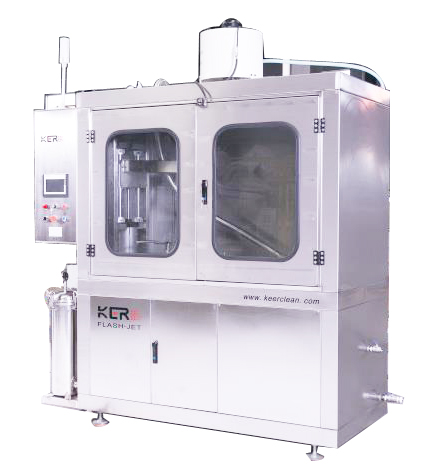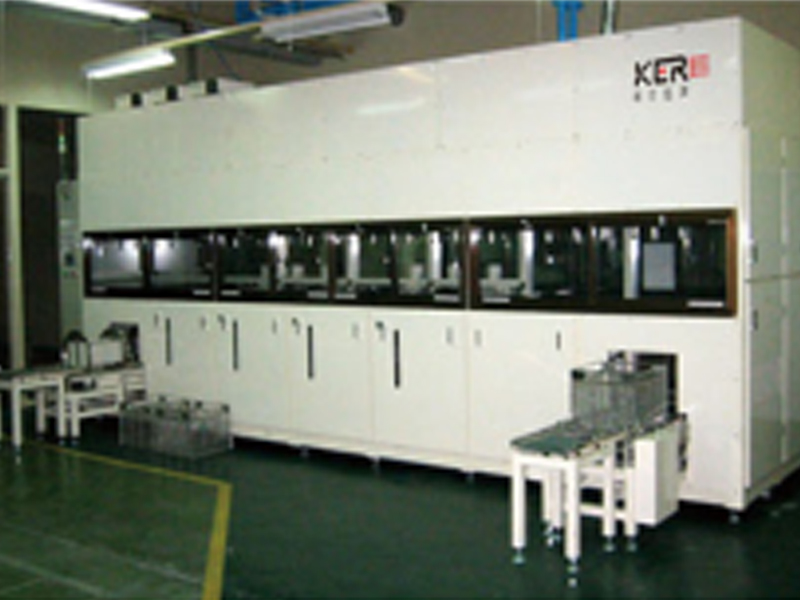
低温废水回收设备:氨氮废水处理技术及研究现状
作者:创始人来源:http://www.jnthcsb.com/时间:2025-11-17
由于低温严重抑制微生物的数量和活性,冬季的氨氮废水处理效率下降严重,达标存在很大的困难。针对上述问题,归纳了在低温条件下(≤15℃)氨氮废水去除的可选技术方法和改进工艺,包括生物脱氮改进技术、物化脱氮技术和高级氧化脱氮技术;指出了氨氮的高效经济处理以及资源化回收利用是今后低温环境下氨氮废水处理的主要发展方向。
Due to the severe inhibition of microbial quantity and activity by low temperatures, the efficiency of ammonia nitrogen wastewater treatment in winter decreases significantly, making it difficult to meet standards. In response to the above issues, optional technical methods and improved processes for the removal of ammonia nitrogen wastewater under low temperature conditions (≤ 15 ℃) have been summarized, including biological denitrification improvement technology, physicochemical denitrification technology, and advanced oxidation denitrification technology; It is pointed out that the efficient and economical treatment of ammonia nitrogen, as well as the resource recycling and utilization, are the main development directions for the treatment of ammonia nitrogen wastewater in low-temperature environments in the future.
氨氮是造成水污染的主要污染物之一。传统的生物脱氮技术通过微生物作用对废水中的氨氮进行去除。然而,在高纬度地区,氮排放难以达标的情况却没有得到明显的改善。这是由于温度作为微生物生长繁殖的重要因素对生物处理过程的效率影响很大。每当温度降低10℃,微生物的酶促反应速率降低至原来的1/2,硝化细菌和反硝化细菌的活性受到明显抑制甚至出现生命活动停滞的现象,微生物的生理特性受到巨大影响,且氧化还原电位、溶解氧浓度、污泥体积指数和胞内外聚合物的含量也随温度变化而变化,因此,低温环境严重抑制了微生物法对氨氮废水的处理效果。
Ammonia nitrogen is one of the main pollutants causing water pollution. Traditional biological denitrification technology removes ammonia nitrogen from wastewater through microbial action. However, in high latitude regions, there has been no significant improvement in the difficulty of meeting nitrogen emission standards. This is because temperature, as an important factor in microbial growth and reproduction, has a significant impact on the efficiency of biological treatment processes. Whenever the temperature drops by 10 ℃, the enzymatic reaction rate of microorganisms decreases to half of its original rate, and the activity of nitrifying and denitrifying bacteria is significantly inhibited, even leading to the stagnation of life activities. The physiological characteristics of microorganisms are greatly affected, and the redox potential, dissolved oxygen concentration, sludge volume index, and content of intracellular and extracellular polymers also change with temperature. Therefore, the low-temperature environment seriously inhibits the treatment effect of microbial methods on ammonia nitrogen wastewater.
近年来,关于低温下脱氮处理技术的核心主要有以下几个方面:①现有脱氮工艺的改进和新脱氮工艺的开发。②通过生物强化的技术手段培育低温耐受性的菌株。③研制新型高效的脱氮功能材料。④对不同脱氮工艺进行联用,实现优势技术互补。之后再根据氨氮废水不同的水质特性和处理要求选择适当后续工艺,使得氨氮得到高效、低耗、合理地消除或利用。根据氨氮废水处理的技术原理不同,本文中将分别从生物脱氮改进技术、物化脱氮技术和高级氧化脱氮技术3方面进行介绍。
In recent years, the core of low-temperature denitrification treatment technology mainly includes the following aspects: ① Improvement of existing denitrification processes and development of new denitrification processes. ② Cultivate low-temperature tolerant strains through biological reinforcement techniques. ③ Develop new and efficient denitrification functional materials. ④ Combine different denitrification processes to achieve complementary advantages in technology. Afterwards, appropriate follow-up processes will be selected based on the different water quality characteristics and treatment requirements of ammonia nitrogen wastewater, so that ammonia nitrogen can be efficiently, low in consumption, and reasonably eliminated or utilized. Based on the different technical principles of ammonia nitrogen wastewater treatment, this article will introduce three aspects: biological denitrification improvement technology, physicochemical denitrification technology, and advanced oxidation denitrification technology.
1生物脱氮改进技术
1. Improvement technology for biological denitrification
1.1 低温生物强化技术?
1.1 Low temperature biological enhancement technology?
生物强化技术是指向生物系统中投加具有特殊功能的微生物以改善原有系统中对某种难降解污染物去除效果的一类方法。当外部环境温度较低时,传统脱氮过程(氨化、硝化、反硝化)受到严重抑制,生物强化技术可以有效地改善低温环境下的脱氮效果。
Biological enhancement technology refers to a method of adding microorganisms with special functions to biological systems to improve the removal efficiency of certain recalcitrant pollutants in the original system. When the external environmental temperature is low, traditional denitrification processes (ammonification, nitrification, denitrification) are severely inhibited, and biological enhancement technology can effectively improve denitrification efficiency in low-temperature environments.
1.1.1??低温菌群驯养强化氨氮去除技术生物处理过程中低温对微生物活性和数量的影响是导致生物处理效果变差的根本因素,因而培育耐低温的微生物是提高氨氮处理效率的一种常用方法。杨墨等在冬季(10℃)从松花江底泥中筛选分离出脱氮效率最高的低温硝化菌株M-33,可以在24 h以内高效去除90%以上氨氮且反应过程中无亚硝态氮积累。Tian等将亚硝酸根完全自养脱氮(CANON)用于污水处理的过程中,探究了10、20、30℃温度下的的厌氧氨氧化菌(AAOB)丰度和肼合酶(HZS)表达水平,发现10℃时AAOB活性高于其他体系,颗粒中HZS表达增加,在基因水平上形成了具有较好短期低温抗性和恢复能力的等效体系。
1.1.1?? The domestication of low-temperature microbial communities and the enhancement of ammonia nitrogen removal technology are the fundamental factors leading to the deterioration of biological treatment efficiency due to the impact of low temperature on microbial activity and quantity during the biological treatment process. Therefore, cultivating low-temperature tolerant microorganisms is a commonly used method to improve ammonia nitrogen treatment efficiency. Yang Mo et al. screened and isolated the low-temperature nitrification strain M-33 with the highest denitrification efficiency from the sediment of Songhua River in winter (10 ℃). It can efficiently remove over 90% of ammonia nitrogen within 24 hours without accumulating nitrite nitrogen during the reaction process. Tian et al. investigated the abundance of anaerobic ammonia oxidizing bacteria (AAOB) and the expression level of hydrazine synthase (HZS) at temperatures of 10, 20, and 30 ° C during the complete autotrophic denitrification of nitrite (CANON) in wastewater treatment. They found that AAOB activity was higher at 10 ° C than in other systems, and the expression of HZS in particles increased, forming an equivalent system with good short-term low-temperature resistance and recovery ability at the genetic level.
此外,研究人员发现通过逐步降温驯化出适宜低温环境的微生物,可以达到较好的氨氮处理效果。Lv等在温度从35℃降至10℃的过程中,发现厌氧氨氧化细菌和异养细菌保持较高活性,脱氮效率在90%以上。然而,直接投加耐冷菌存在菌种流失、生存率低等问题,采用一定的生物固定化技术可以有效地缓解上述问题。许祥祥等利用聚乙烯醇-海藻酸钠包埋厌氧氨氧化污泥颗粒处理低温氨氮废水,证实了通过包埋固定的方式能有效地提高低温下氨的去除性能。
In addition, researchers have found that by gradually cooling down and domesticating microorganisms suitable for low-temperature environments, good ammonia nitrogen treatment effects can be achieved. During the process of reducing the temperature from 35 ℃ to 10 ℃, Lv et al. found that anaerobic ammonia oxidizing bacteria and heterotrophic bacteria maintained high activity, with a denitrification efficiency of over 90%. However, direct addition of cold tolerant bacteria poses problems such as bacterial loss and low survival rate. The use of certain biological immobilization techniques can effectively alleviate these issues. Xu Xiangxiang et al. used polyvinyl alcohol sodium alginate to embed anaerobic ammonium oxidation sludge particles for the treatment of low-temperature ammonia nitrogen wastewater, and confirmed that the embedding fixation method can effectively improve the removal performance of ammonia at low temperatures.
1.1.2??共代谢作用强化氨氮去除技术投加碳源和特定金属元素以及某类氧化还原介体可以提高低温下生物脱氮效率,这类共代谢基质和营养物质的投放也是实现低温生物强化手段的有效途径之一。
1.1.2?? The co metabolism enhanced ammonia nitrogen removal technology can improve the biological denitrification efficiency at low temperatures by adding carbon sources, specific metal elements, and certain redox mediators. The release of such co metabolism substrates and nutrients is also an effective way to achieve low-temperature biological enhancement.
Li等研究发现低温条件下(15℃)利用Fe3+会增强SBR的脱氮效果,当Fe(Ⅲ)的投加量为6 mg/L条件下,氨氮、亚硝酸盐的去除率分别增加到0.42、0.53 kg/(m3·d)。此外,胞外聚合物(EPS)和聚羟基脂肪酸酯(PHA)有利于微生物抵御外界环境变化,促进低温下生物脱氮有效进行。Collins等研究了细胞外聚合物质有关的适应性特性,发现EPS的凝胶基质阻碍了溶质扩散,从而降低了废水处理中因低温导致的渗透压和干燥损伤。
Li et al. found that the use of Fe3+under low temperature conditions (15 ℃) enhances the denitrification efficiency of SBR. When the dosage of Fe (III) is 6 mg/L, the removal rates of ammonia nitrogen and nitrite increase to 0.42 and 0.53 kg/(m3 · d), respectively. In addition, extracellular polymers (EPS) and polyhydroxyalkanoates (PHA) are beneficial for microorganisms to resist external environmental changes and promote effective biological denitrification at low temperatures. Collins and others studied the adaptability related to extracellular polymeric substances, and found that the gel matrix of EPS hindered the diffusion of solutes, thereby reducing the osmotic pressure and drying damage caused by low temperature in wastewater treatment.
1.2 脱氮工艺的参数优化及工序创新?
1.2 Parameter optimization and process innovation of denitrification process?
调节工艺参数是保证低温下脱氮工艺稳步运行的首要策略,池体升温保温、增加水力停留时间、碳氮比、延长曝气时间和降低污泥负荷等是实现低温下脱氮工艺稳定进行的关键因素。Gao等研究了厌氧/好氧/缺氧(AOA)在低温15℃条件下,在以低碳氮比(3.36)处理真实城市污水,TIN、NH4+-N去除率分别为(84.3±6.6)%、(97.4±3.3)%。
Adjusting process parameters is the primary strategy to ensure the stable operation of denitrification processes at low temperatures. Key factors for achieving stable denitrification processes at low temperatures include temperature and insulation of the tank, increasing hydraulic retention time, carbon nitrogen ratio, extending aeration time, and reducing sludge load. Gao et al. studied the anaerobic/aerobic/anoxic (AOA) treatment of real urban wastewater at a low temperature of 15 ℃ with a low carbon to nitrogen ratio (3.36). The removal rates of TIN and NH4+- N were (84.3 ± 6.6)% and (97.4 ± 3.3)%, respectively.
此外,通过调整工艺顺序、增加工艺流程和改良运行模式的手段等同样可以增强低温环境下的氨氮去除效果。陈杰云等通过倒置A2/O工艺处理氨氮废水,在低温季对氨氮去除率可达到88%。吴迪等采用镶嵌式理念改良A2/O-MBBR工艺,在厌氧区与好氧区的基础上分割出缺氧区,并在好氧区中添加SPR-2型悬浮填料,出水水质满足国家一级A排放标准,氨氮去除率高达97.9%。
In addition, adjusting the process sequence, increasing the process flow, and improving the operating mode can also enhance the removal efficiency of ammonia nitrogen in low-temperature environments. Chen Jieyun et al. treated ammonia nitrogen wastewater using the inverted A2/O process, and achieved a removal rate of 88% for ammonia nitrogen during the low-temperature season. Wu Di and others adopted the embedded concept to improve the A2/O-MBBR process, dividing the anoxic zone into anaerobic and aerobic zones, and adding SPR-2 suspended packing in the aerobic zone. The effluent quality meets the national first-class A emission standard, and the ammonia nitrogen removal rate is as high as 97.9%.
1.3 多级工艺联合?
1.3 Multi level process combination?
通过与其他生物处理装置进行工艺联合,能有效改善低温下水体氨氮的去除效果。Zha等开发了一种缺氧过滤器/多级水车驱动旋转生物接触器装置处理低温(6~18℃)下低浓度生活污水。在45 d内,NH4+-N的平均去除效率达到(75.5±1.86)%,TN的平均去除效率达到(44.81±3.67)%。李冬等利用两级曝气+两级过滤的生物净化工艺低温下(5.0~7.8℃)去除氨氮高达99.33%,去除负荷为29.66 g/(m·h)。Ren等研究了在10℃条件下,铁负载生物活性炭滤池(Fe-BACF)去除模拟二次废水中的氨氮。采用超声浸渍法负载铁活性炭(Fe-AC)作为生物滤池工艺的过滤材料,在滤料表面形成生物膜后,Fe-BACF对氨氮的平均去除率(97.9%)显著高于常规BACF(87.8%)。
By combining with other biological treatment devices, the removal efficiency of ammonia nitrogen in water at low temperatures can be effectively improved. Zha et al. developed an anoxic filter/multi-stage waterwheel driven rotating biological contactor device for treating low concentration domestic sewage at low temperatures (6-18 ℃). Within 45 days, the average removal efficiency of NH4+- N reached (75.5 ± 1.86)%, and the average removal efficiency of TN reached (44.81 ± 3.67)%. Li Dong et al. used a biological purification process of two-stage aeration and two-stage filtration to remove up to 99.33% of ammonia nitrogen at low temperatures (5.0~7.8 ℃), with a removal load of 29.66 g/(m · h). Ren et al. studied the removal of ammonia nitrogen from simulated secondary wastewater using iron loaded biochar filter (Fe BACF) at 10 ℃. The ultrasonic impregnation method was used to load iron activated carbon (Fe AC) as the filtration material for the biofilter process. After forming a biofilm on the surface of the filter material, the average removal rate of ammonia nitrogen by Fe BACF (97.9%) was significantly higher than that of conventional BACF (87.8%).
2物化脱氮技术
2 Physical and Chemical Denitrification Technologies
物化脱氮技术是通过物理化学的手段去除水体中的氨氮和有毒有害的污染物质,是一类较为成熟的脱氮处理工艺,低温下效果比较稳定的物化法包括化学沉淀法、折点氯化法、膜分离法等,缺点是处理费用昂贵,不适合处理大规模的废水。
Physical and chemical denitrification technology is a mature denitrification treatment process that removes ammonia nitrogen and toxic and harmful pollutants from water bodies through physical and chemical means. Physical and chemical methods with stable effects at low temperatures include chemical precipitation, breakpoint chlorination, membrane separation, etc. The disadvantage is that the treatment cost is expensive and not suitable for treating large-scale wastewater.
2.1 化学沉淀法?
2.1 Chemical precipitation method?
磷酸铵镁法(鸟粪石)是现阶段较为成熟的技术,是通过向氨氮废水中加入镁离子和磷酸根离子来生成MgNH4PO4?6H2O沉淀物质,后者可用作复合肥料实现氨氮的二次利用。为寻找高效低廉的化学药剂进一步改善磷酸铵镁法的处理效果,Siciliano等提出了一种基于磷酸铵镁化学沉淀的工艺并使用海水盐卤和骨粉用作镁和磷的低成本试剂有效地回收,该工艺可以去除90%以上的氨氮,并生成含有鸟粪石晶体的有潜在价值的沉淀物。此外,化学沉淀法也可与吸附法联用。Ren等研究结果表明,改性Fe-AC可有效去除低浓度低温废水中的氨氮,Fe-AC对氨氮的吸附量比AC高54.4%。
The magnesium ammonium phosphate method (bird guano stone) is a relatively mature technology at present, which generates MgNH4PO4 by adding magnesium ions and phosphate ions to ammonia nitrogen wastewater? 6H2O precipitation material can be used as a compound fertilizer to achieve secondary utilization of ammonia nitrogen. In order to find efficient and low-cost chemical agents to further improve the treatment effect of the magnesium ammonium phosphate method, Siciliano et al. proposed a process based on magnesium ammonium phosphate chemical precipitation and used seawater brine and bone powder as low-cost reagents for the effective recovery of magnesium and phosphorus. This process can remove more than 90% of ammonia nitrogen and generate potentially valuable precipitates containing bird guano crystals. In addition, chemical precipitation method can also be combined with adsorption method. The research results of Ren et al. showed that modified Fe AC can effectively remove ammonia nitrogen from low concentration and low-temperature wastewater, and the adsorption capacity of Fe AC for ammonia nitrogen is 54.4% higher than that of AC.
2.2 折点氯化法?
2.2 Conversion point chlorination method?
折点氯化法是向氨氮废液中通入氯气或加入次氯酸钠将废水中的氨氮转化为氮气的一种方法。水中的氨氮浓度会随着氯气的增加而降低,氨氮浓度为零的点被称为折点,反应机理为:NH4++1.5HOCl→0.5N2+1.5H2O+2.5H++1.5Cl-折点氯化法相较于其他的物化技术最大优势在于根据处理液的实际情况(pH、温度、氨氮浓度),通过控制加氯量实现完全脱氮并同时达到消毒目的。然而,折点氯化法会引起二次污染。处理过程中,可以通过折点氯化和其他工艺组合来实现优势互补。黄万抚等通过磷酸铵镁沉淀法(MAP)和折点氯化法联合工艺对氨氮废水进行有效处理。结果表明,pH为9.5、N/Cl2的摩尔比为1/1.6时,氨氮处理效果为98.8%。
The breakpoint chlorination method is a method of converting ammonia nitrogen in wastewater into nitrogen gas by introducing chlorine gas or adding sodium hypochlorite into the wastewater. The concentration of ammonia nitrogen in water will decrease with the increase of chlorine gas. The point where the ammonia nitrogen concentration is zero is called the inflection point. The reaction mechanism is: NH4++1.5HOCl → 0.5N2+1.5H2O+2.5H++1.5Cl - inflection point chlorination. Compared with other physicochemical technologies, the biggest advantage of the chlorination method is to achieve complete denitrification and disinfection by controlling the amount of chlorine added according to the actual situation of the treatment solution (pH, temperature, ammonia nitrogen concentration). However, the breakpoint chlorination method can cause secondary pollution. During the processing, complementary advantages can be achieved through the combination of point chlorination and other processes. Huang Wanfu et al. effectively treated ammonia nitrogen wastewater through a combined process of magnesium ammonium phosphate precipitation (MAP) and breakpoint chlorination. The results showed that when the pH was 9.5 and the molar ratio of N/Cl2 was 1/1.6, the ammonia nitrogen treatment effect was 98.8%.
2.3 膜分离法?
2.3 Membrane separation method?
膜分离法是在压力作用下通过膜对溶液中某种成分选择性分离的一种方法,可分为电渗析、反渗透、微滤、纳滤、超滤等。对于氨氮废液的水质和水量变化具有较强的抗变性,不受温度和pH波动的影响。但会出现膜堵塞和膜污染现象,对于低浓度氨氮废水处理效果较好,但是在处理高浓度有机废水时需要进行反复清洗,产生的清洗液对环境会造成二次污染,因此,需要与其他工艺联用才能达到较好的处理效果。邢金良等结合阳离子交换膜-超滤(CEM-UF)组合膜与硝化/反硝化过程处理氨氮废水。当进水总氮(TN)为60 mg/L,COD/TN为2.65时,氨氮去除率为98.7%。
Membrane separation is a method of selectively separating a certain component in a solution through a membrane under pressure, which can be divided into electrodialysis, reverse osmosis, microfiltration, nanofiltration, ultrafiltration, etc. It has strong resistance to changes in water quality and quantity of ammonia nitrogen waste liquid, and is not affected by temperature and pH fluctuations. However, membrane blockage and fouling may occur, and the treatment effect is good for low concentration ammonia nitrogen wastewater. However, repeated cleaning is required when treating high concentration organic wastewater, and the resulting cleaning solution will cause secondary pollution to the environment. Therefore, it needs to be combined with other processes to achieve better treatment effects. Xing Jinliang et al. combined cation exchange membrane ultrafiltration (CEM-UF) composite membrane with nitrification/denitrification process to treat ammonia nitrogen wastewater. When the total nitrogen (TN) in the influent is 60 mg/L and the COD/TN ratio is 2.65, the removal rate of ammonia nitrogen is 98.7%.
3高级氧化脱氮技术
3 Advanced Oxidation Denitrification Technologies
高级氧化脱氮技术主要是利用反应产生的强氧化物质(羟基自由基等)与氨氮充分反应,最终使氨氮从水体中脱除的目的。
Advanced oxidation denitrification technology mainly utilizes the strong oxidizing substances (such as hydroxyl radicals) generated by the reaction to fully react with ammonia nitrogen, ultimately achieving the goal of removing ammonia nitrogen from the water.
3.1 臭氧氧化技术?
3.1 Ozone oxidation technology?
臭氧氧化法是利用O3和分解产生的自由基作为强氧化剂对污染物进行降解的一类方法。研究表明,低温环境下对pH进行适当调控,可以对氨氮废水实现较好的脱氮效果。Liu等研究了低温下(10℃)通过MgO催化臭氧氧化反应去除水中的氨,发现较低的pH有利于选择性生成气态产物(N2或N2O)。在pH为9时,氨的去除效率显著提高,在0~10℃的温度范围内实现了较高的氨去除率(77.53%~80.17%)。由于O3较高的处理成本,臭氧氧化技术往往需要和其他工艺联用。刘春等通过微气泡臭氧催化氧化-生化耦合工艺对工业废水进行处理,发现微气泡臭氧催化氧化能有效降解废水中的氨氮,出水氨氮平均浓度为5.1 mg/L,且臭氧利用率接近100%。
Ozone oxidation is a type of method that uses O3 and the free radicals generated by decomposition as strong oxidants to degrade pollutants. Research has shown that adjusting pH appropriately in low-temperature environments can achieve good denitrification effects on ammonia nitrogen wastewater. Liu et al. studied the removal of ammonia from water by MgO catalyzed ozone oxidation reaction at low temperature (10 ℃) and found that lower pH is conducive to the selective generation of gaseous products (N2 or N2O). At pH 9, the removal efficiency of ammonia was significantly improved, achieving a high ammonia removal rate (77.53%~80.17%) within the temperature range of 0~10 ℃. Due to the high processing cost of O3, ozone oxidation technology often needs to be combined with other processes. Liu Chun et al. treated industrial wastewater using a microbubble ozone catalytic oxidation biochemical coupling process and found that microbubble ozone catalytic oxidation can effectively degrade ammonia nitrogen in wastewater. The average concentration of ammonia nitrogen in the effluent was 5.1 mg/L, and the ozone utilization rate was close to 100%.
3.2 电化学氧化技术?
3.2 Electrochemical oxidation technology?
电化学氧化法有直接氧化和间接氧化2种方法。前者是利用电极直接接触的方式与氨氮进行电子转移,后者是通过电极产生的强氧化物与氨氮发生反应,最终达到氨氮去除的目的。由于实际生活中氨氮废水的复杂性,单独的电化学氧化技术无法达到预期要求,Zhou等研究了两阶段电化学过程(鸟粪石电化学沉淀和氨电氧化)用于处理水解污泥的上清液。在最佳条件下,碱性水解污泥的上清液氨氮去除率为79.3%。
There are two methods of electrochemical oxidation: direct oxidation and indirect oxidation. The former uses direct electrode contact to transfer electrons with ammonia nitrogen, while the latter reacts with ammonia nitrogen through the strong oxide generated by the electrode, ultimately achieving the goal of ammonia nitrogen removal. Due to the complexity of ammonia nitrogen wastewater in practical life, single electrochemical oxidation technology cannot meet the expected requirements. Zhou et al. studied a two-stage electrochemical process (bird guano stone electrochemical precipitation and ammonia electro oxidation) for treating the supernatant of hydrolyzed sludge. Under optimal conditions, the removal rate of ammonia nitrogen in the supernatant of alkaline hydrolyzed sludge is 79.3%.
此外,低温电化学反应过程中存在界面焦耳热(IJH)效应,即阳极施加电流会将热量散发到周围的环境中,从而导致界面温度远高于本体溶液的界面温度。Pei等对电化学氧化过程中界面焦耳热效应进行了表征。实验结果表明,在电流密度为10 mA/cm2的情况下电解120 min后,界面温度从25℃升高到70.2℃。利用界面焦耳效应,在水温低至8.5±1℃、电流密度增加到20 mA/cm2的情况下,界面温度急剧增加到38.7℃,在此温度下苯酚、对氯苯酚和2,4-二氯苯氧基乙酸的氧化速率分别为0.158、0.084、0.070 min-1,与室温(23.5±1℃)下所得值几乎相等。
In addition, there is an interface Joule heating (IJH) effect in the low-temperature electrochemical reaction process, which means that applying current to the anode will dissipate heat to the surrounding environment, resulting in an interface temperature much higher than that of the bulk solution. Pei et al. characterized the Joule heating effect at the interface during electrochemical oxidation process. The experimental results showed that after 120 minutes of electrolysis at a current density of 10 mA/cm2, the interface temperature increased from 25 ℃ to 70.2 ℃. By utilizing the Joule effect at the interface, the interface temperature rapidly increases to 38.7 ℃ at a water temperature as low as 8.5 ± 1 ℃ and a current density of 20 mA/cm2. At this temperature, the oxidation rates of phenol, p-chlorophenol, and 2,4-dichlorophenoxyacetic acid are 0.158, 0.084, and 0.070 min-1, respectively, which are almost equal to the values obtained at room temperature (23.5 ± 1 ℃).
3.3 光催化氧化技术?
3.3 Photocatalytic oxidation technology?
光催化氧化法是以半导体作为光催化剂,在光照下产生有效电子和空穴,利用光生空穴和后续产生的羟基自由基,对氨氮进行氧化。He等研究了Cu/ZnO/rGO在可见光下对NH4+-N的光催化降解效能。发现在氙灯照射2 h,NH4+-N去除率高达83.1%。此外,使用Cu/ZnO/rGO处理实际生活污水,总氮的去除效率达到80.7%。
The photocatalytic oxidation method uses semiconductors as photocatalysts to generate effective electrons and holes under illumination, and utilizes the photo generated holes and subsequently generated hydroxyl radicals to oxidize ammonia nitrogen. He et al. investigated the photocatalytic degradation efficiency of Cu/ZnO/rGO towards NH4+- N under visible light. It was found that after 2 hours of xenon lamp irradiation, the removal rate of NH4+- N was as high as 83.1%. In addition, the use of Cu/ZnO/rGO to treat actual domestic sewage achieved a total nitrogen removal efficiency of 80.7%.
为了提高氨氮氧化过程中N2产物的选择性,多项研究以Pt或Ru等作为助催化剂。例如,Dozzi等发现Pt(0.8%)与Ru(0.1%)作为助催化剂沉积在TiO2上可将70%的NH3催化氧化成N2。然而,贵金属的使用大大提高了光催化过程的成本。部分研究工作者将光催化技术与反硝化菌相结合,利用细菌的反硝化作用来完成NO2-、NO3-向N2的转变。
In order to improve the selectivity of N2 products in the process of ammonia nitrogen oxidation, multiple studies have used Pt or Ru as co catalysts. For example, Dozzi et al. found that Pt (0.8%) and Ru (0.1%) as co catalysts deposited on TiO2 can catalyze the oxidation of 70% of NH3 to N2. However, the use of precious metals greatly increases the cost of the photocatalytic process. Some researchers have combined photocatalytic technology with denitrifying bacteria to utilize their denitrification process to complete the conversion of NO2- and NO3- to N2.
4低温氨氮废水处理技术对比
Comparison of Low Temperature Ammonia Nitrogen Wastewater Treatment Technologies
由于处理技术之间存在较大差异,可根据氨氮废水的各类水质参数并结合实际情况选择较为合适的处理方法。
Due to significant differences in treatment technologies, a more suitable treatment method can be selected based on various water quality parameters of ammonia nitrogen wastewater and combined with actual conditions.
5结论与展望
5 Conclusion and Prospect
针对低温条件下生物活性降低、脱氮微生物酶促反应受到抑制等问题,可通过生物强化技术驯养出耐低温微生物,优化生物脱氮工艺以及多工艺联用等手段对氨氮废水进行综合性生物处理。在物化脱氮技术中面对不同水质特征的氨氮废水,可调控影响污染物去除效率的因素,采取联合工艺、实现技术优势互补,以彻底去除水体中的氨氮,最终达到提高出水水质的目的。而高级氧化技术作为现阶段新型的水处理工艺,目前由于发展不太成熟、处理成本昂贵、反应条件苛刻等特点限制了在实际中的大规模应用。
To address the issues of decreased biological activity and inhibited enzymatic reactions of denitrifying microorganisms under low temperature conditions, low-temperature tolerant microorganisms can be trained through biological enhancement technology, and comprehensive biological treatment of ammonia nitrogen wastewater can be achieved by optimizing biological denitrification processes and combining multiple processes. In the physical and chemical denitrification technology, when facing ammonia nitrogen wastewater with different water quality characteristics, factors affecting pollutant removal efficiency can be regulated. Joint processes can be adopted to achieve complementary technological advantages, in order to completely remove ammonia nitrogen from the water body and ultimately improve the effluent quality. However, advanced oxidation technology, as a new type of water treatment process at present, is limited in its large-scale application due to its immature development, expensive treatment costs, and harsh reaction conditions.
结合国内外对低温下氨氮废水处理研究及其发展态势来看,笔者认为氨氮的高效经济处理以及资源化回收利用将成为低温环境下氨氮废水处理的主要发展方向。
Based on the research and development trend of low-temperature ammonia nitrogen wastewater treatment at home and abroad, the author believes that efficient and economical treatment of ammonia nitrogen and resource recycling will become the main development direction of low-temperature ammonia nitrogen wastewater treatment.
本文由 低温废水处理设备 友情奉献.更多有关的知识请点击 http://www.jnthcsb.com/ 真诚的态度.为您提供为全面的服务.更多有关的知识我们将会陆续向大家奉献.敬请期待.
This article is a friendly contribution from low-temperature wastewater treatment equipment For more related knowledge, please click http://www.jnthcsb.com/ Sincere attitude To provide you with comprehensive services We will gradually contribute more relevant knowledge to everyone Coming soon.
 公司:济南科尔超声波设备有限公司
公司:济南科尔超声波设备有限公司  热线:18663767799
热线:18663767799 地址:山东省济南市济阳区创业路与启航街交叉口南40米
地址:山东省济南市济阳区创业路与启航街交叉口南40米








 常见问题
常见问题

 联系我们
联系我们
 咨询电话:18663767799
咨询电话:18663767799 E-MAIL:jnkergs@163.com
E-MAIL:jnkergs@163.com 地址:山东省济南市济阳区创业路与启航街交叉口南40米
地址:山东省济南市济阳区创业路与启航街交叉口南40米 鲁公网安备 37011202001385号
鲁公网安备 37011202001385号
